| dc.contributor.advisor | Edwin L. Thomas. | en_US |
| dc.contributor.author | Gorishnyy, Taras | en_US |
| dc.contributor.other | Massachusetts Institute of Technology. Dept. of Materials Science and Engineering. | en_US |
| dc.date.accessioned | 2008-09-03T14:41:07Z | |
| dc.date.available | 2008-09-03T14:41:07Z | |
| dc.date.copyright | 2007 | en_US |
| dc.date.issued | 2007 | en_US |
| dc.identifier.uri | http://hdl.handle.net/1721.1/42133 | |
| dc.description | Thesis (Ph. D.)--Massachusetts Institute of Technology, Dept. of Materials Science and Engineering, 2007. | en_US |
| dc.description | Includes bibliographical references (p. 133-140). | en_US |
| dc.description.abstract | Manipulation of the distribution of phonons inM a solid is important for both basic science and applications ranging from heat management to reduction of noise in electronic circuits and creating materials with superior acoustic and acousto-optical properties. This thesis explores hypersonic phononic crystals as means to achieve control over high frequency acoustic phonons. An integrated approach to fabrication, measurement and analysis of hypersonic phononic crystals with band gaps in the GHz range is presented. First, the phonon dispersion relation for one dimensional polymeric phononic crystals fabricated by coextrusion of a large number of poly(methylmethacrylate)/poly(carbonate) and poly(methylmethacrylate)/poly(ethylene terephthalate) bilayer pairs is investigated as a function of a lattice constant and composition using Brillouin light scattering and numerical simulations. This set of relatively simple multilayer structures represents an excellent platform to gain a basic understanding of phononic band gap phenomena. In addition, their in-plane phonon dispersion is used to extract information about the elastic constants and glass transition temperatures of individual nanolayers in a periodic multilayer arrangement. Next, two dimensional epoxy/air phononic crystals fabricated in a photoresist using interference lithography are studied. These structures are 2D single crystalline, enabling direction-resolved measurements of their phonon dispersion relation. As a result, the complete experimental phononic band diagram is obtained and correlated with numerical simulations. Finally, phononic properties of three dimensional elastomeric poly(dimethylsiloxane) crystals are investigated and the mechanical tunability of their dispersion relation is demonstrated. | en_US |
| dc.description.abstract | (cont.) This set of structures forms the basis for understanding how to design and fabricate acoustic and acousto-optical devices with performance characteristics that can be adjusted dynamically during operation. The investigations described in this thesis demonstrate both theoretically and experimentally that 1D, 2D and 3D periodic submicron structures have complex phonon dispersion relations at GHz frequencies. As a result, these crystals can be used to manipulate the flow of random thermal phonons as well as externally generated acoustic waves resulting in novel acoustic and thermal properties. | en_US |
| dc.description.statementofresponsibility | by Taras Gorishnyy. | en_US |
| dc.format.extent | 140 p. | en_US |
| dc.language.iso | eng | en_US |
| dc.publisher | Massachusetts Institute of Technology | en_US |
| dc.rights | M.I.T. theses are protected by
copyright. They may be viewed from this source for any purpose, but
reproduction or distribution in any format is prohibited without written
permission. See provided URL for inquiries about permission. | en_US |
| dc.rights.uri | http://dspace.mit.edu/handle/1721.1/7582 | en_US |
| dc.subject | Materials Science and Engineering. | en_US |
| dc.title | Hypersonic phononic crystals | en_US |
| dc.type | Thesis | en_US |
| dc.description.degree | Ph.D. | en_US |
| dc.contributor.department | Massachusetts Institute of Technology. Department of Materials Science and Engineering | |
| dc.identifier.oclc | 228298585 | en_US |
